Abstract With the concept of car networking, a new concept of vehicle maintenance management and its implementation scheme are introduced. The solution utilizes OBD and C/S network architecture to realize remote collection of vehicle information and form a back-end data system, thereby realizing centralized management and application of automobile information, and ultimately providing car owners with a more thoughtful service experience by improving the interests of automobile manufacturers. In this paper, a series of discussions on the implementation framework, rationality, feasibility and application value of the scheme are given, and the specific implementation technical points and simulations are given, including the application of OBD system in automobile information collection. This article refers to the address: http:// Led Neon Flex ,Neon Flex Adalah,Flexible Led Neon Strip Lights,Led Neon Tube Lights NINGBO SENTU ART AND CRAFT CO.,LTD. , https://www.sentuledlight.com
Keywords vehicle information collection; remote monitoring; background data system; OBD system
Vehicle networking refers to the identification of electronic tags on vehicles by wireless radio frequency and other identification technologies. It realizes the extraction and effective utilization of all vehicle attributes and static and dynamic information on the information network platform, and all of them according to different functional requirements. The vehicle's operational status is effectively regulated and provides integrated services.
In the 1960s, the concept of car networking has appeared in developed countries and regions such as the United States, Europe and Japan, and has developed ITS, IVHS, RTI, VICS and other car networking systems. At home, the 4th National GPS Operator Conference, the concept of car networking was first proposed and recognized by the majority of professionals; at the China International IoT Conference held in Wuxi, the country listed the car network as the third special project of China's major special projects. In the important project, China’s car network started. Up to now, some in-vehicle systems provided by some suppliers have basically realized functions such as intelligent navigation, maintenance reservations, and consultation and inquiry, which is more convenient for vehicles to travel and improves the driving experience to a certain extent.
In addition to providing users with a better driving experience, the development of the Internet of Vehicles should also provide powerful back-end data feedback services for car manufacturers or 4S stores. This also makes sense for their business expansion and service extension. Powerful data feedback can respond to sudden abnormal conditions of the vehicle and provide a basis for analyzing the quality of the vehicle. Historical data can provide targeted and personalized maintenance services for specific vehicle types.
The paper provides a solution with powerful background data feedback functions such as real-time vehicle condition information monitoring, abnormal vehicle alarm and driving data record. The vehicle system uploads the vehicle status information and uploads it to the server. The administrator can log in to the solution system. The information center uses a wide range of vehicle remote monitoring, remote location capture and vehicle traffic logs to collect driving data. Through active analysis of data, auto manufacturers can not only provide car owners with higher quality and more active vehicle maintenance services, but also clearly understand the operation status of a certain series of cars, which is obvious to the improvement and optimization of the car types. The contribution can also improve the production efficiency of automobile manufacturers and reduce the maintenance cost of vehicles.
1 Framework analysis of the program The implementation framework of the plan is shown in Figure 1. The whole system is composed of two server/client (C/S) architecture subnets. The vehicle system and the server constitute a vehicle/service information interaction network through the GPRS network; the information center and the server include a multi-network conforming to the TCP/IP protocol. Form an information interaction network. In view of the lack of security in open networks, the information of the two sub-networks uses an encrypted communication scheme to ensure the basic security of the communication data. 
2 main functional module definition of the scheme
2.1 Definition of on-board system function (1) As the source of feedback data, it is the main provider of basic data required by the information center for upper-level services, and interacts with the OBD system to obtain the latest status information of the car in real time.
(2) Accepting task requests from the data server to passively perform data feedback on specific vehicle status information.
(3) According to the setting and the rule of fault definition, when an abnormality occurs in the vehicle system is detected, the abnormal information of the vehicle is actively and timely fed back to the data server.
(4) The direct performer of the real-time record of the car trip information, and periodically uploads the itinerary record to the data server, and combines with the data server to become a complete system of the car trip record. The car trip record is temporarily stored in the local flash area of ​​the in-vehicle system. The flash area has a relatively large storage space and has a power-down hold function. It can act as a black box. When an accident occurs in the car and the abnormal information is not uploaded, the accident can still occur. The latest information is kept in a timely manner.
(5) Support security related mechanisms such as communication encryption and key exchange.
2.2 Data server function definition (1) As the core role of feedback data sharer. The large amount of feedback data received provides a structured data store. Structured data facilitates secondary data processing and is suitable for logical storage isolation from data of different meanings. Implement the functionality of a remote database server.
(2) Accepting data access from the remote information center, correctly executing the task request from the information center, and accepting the request for data access from the information center to the in-vehicle system node, and the delegation mechanism can improve the response to the information center request through the Cache mechanism. speed.
(3) Accept the information from the in-vehicle system node and update the database data using the received information according to certain rules. And the agent completes the task of entrusting data access to the in-vehicle system node from the information center.
(4) Provide authentication services for information centers and in-vehicle system nodes, and provide security mechanisms such as data access control.
(5) Support security-related mechanisms such as communication encryption and key exchange.
2.3 Information Center Function Definition (1) As the main role of deep application of feedback data. The data server is legally accessed and parsed to convert the data into meaningful information for the administrator, including vehicle fault information, vehicle operating parameters, and the like. The use of data local processing analysis enables communication to communicate with code that enriches a large amount of information, thereby reducing network data traffic and reducing the computational burden of the database.
(2) Providing an interface for the remote operation of the data server by the administrator of the information center, including basic information interfaces such as obtaining information request, recording operation request, login authentication, task delegation, etc., and abstracting remote vehicle condition monitoring through software, remote vehicle condition Abnormal and timely response to the functions of the macro application layer.
(3) Support security-related mechanisms such as communication encryption and key exchange.
3 Program feasibility analysis
3.1 Vehicle system solution feasibility analysis On-Board Diagnostics (OBD), which can obtain the internal parameters of the car. OBD was originally used as a displacement monitor to control vehicle emissions. By detecting the state of the engine and the amount of pollutants in the exhaust, the OBD was prompted to maintain the vehicle, and then gradually developed into a comprehensive vehicle monitoring system. If the manufacturer implements all of the PID functions in the OBD standard, OBD can provide information on tire pressure, air flow, pedal position and more.
Since the OBD system cannot notify the user of the cause of the error, the detected OBD data needs to be sent to the remote vendor for analysis, and then the information is fed back to the user.
The OBD system provides a comprehensive understanding of the condition of the car. The standard OBD offers 9 services. 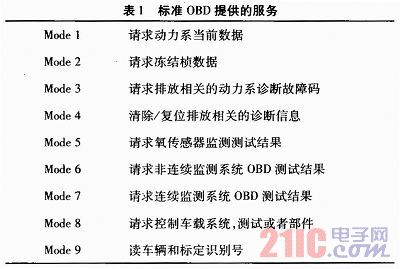
The current state parameters of the car, such as tire pressure, battery voltage, engine speed, and vehicle speed, are obtained mainly through Model. The current fault code is obtained through Mode3, and the freeze frame related to the fault code is returned through Mode2. Use Mode7 to find the error code that may occur in the future.
The OBD protocol supports multiple physics and uses a 29-bit extended CAN bus. There are four kinds of communication ports in OBD. The implementation of these four kinds of communication frames on the CAN protocol is shown in Fig. 2. Fig. 2(a) shows the format of point-to-point communication, and Fig. 2(b) shows the format of broadcast communication. 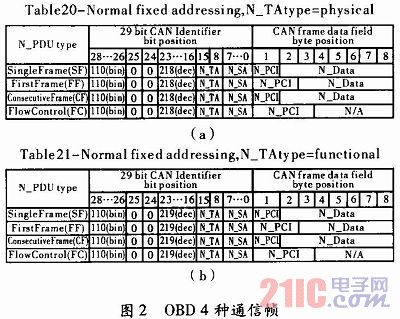
The ELM327 is used as a protocol translator for communication with OBD. The chip supports the ISO15764 protocol and the corresponding CAN bus physical layer, the ISO9141, ISO14230 protocol and the corresponding K-line physical layer, the SAEJ1850 protocol and the corresponding PWM&VPW physical layer, which are converted into Standard serial protocol. Use the ELM327 to increase versatility. Adopt SIM300 as GPRS communication module, adopt
STM32F103RB is the main control chip of the vehicle. The 128 kB Flash can meet the needs of fault information storage. 
3.2 Server Solution Feasibility Analysis 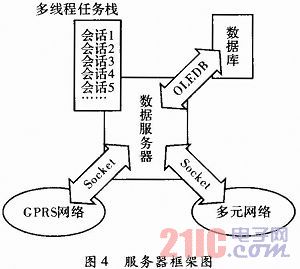
(1) The data communication of the data server adopts the standard TCP/IP protocol, and the data transmission adopts a connection-oriented TCP mode. Due to the wide application of the TCP/IP protocol, most network devices support network transmission based on TCP/IP protocol, and the communication medium is not limited to wired and wireless. At the software layer, the operating system abstracts the data communication of various network devices into a Socket class. In software programming, the network device on the data server can be operated to perform multi-network information interaction by using a Socket-like unified interface.
(2) The data server adopts OLEDB technology. OLEDB abstracts the operation of the multi-database into a unified and standardized application layer interface. In software programming, the OLEDB class can be used to perform simple and standardized data operations on the database, including data structured storage. Data query, data update, etc.
(3) The data server adopts multithreaded information processing mechanism and multi-threaded information processing technology to improve the real-time responsiveness of the server to remote access. For the data server system for multiple users, the multi-threading technology can also be used to perform the logical independence of information processing of different users, so that the single user service generates an abnormal situation to affect other users to a minimum extent, thereby ensuring the robustness of the server. Sex.
3.3 Information Center Program Feasibility Analysis 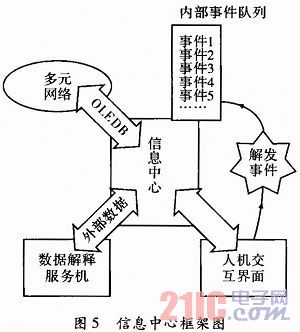
(1) The information center also uses the standard TCP/IP protocol for network communication. The software programming uses the Socket class to standardize the network equipment to communicate with the data server, and the information exchange in the TCP mode makes the information integrity have agreement. Protection.
(2) Using the external data interpretation library to process and analyze the acquired data, which facilitates firmware upgrade of the software.
(3) The event mechanism to process commands from the operator to improve the real-time response speed of the software to human-computer interaction.
4 simulation verification
4.1 Vehicle-side simulation The vehicle-side can obtain vehicle information through OBD and upload it to the server.
4.2 Server Simulation Vehicle information and owner information can be saved on the server side. After the network is configured, the server can be interconnected with the information center to achieve mutual information transmission. 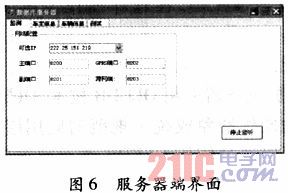
4.3 The information center simulation administrator can query the vehicle information through the login information center, as shown in Figure 7; perform fault processing, as shown in Figure 8; online monitoring, as shown in Figure 9; set the monitoring item, as shown in Figure 10. Show. 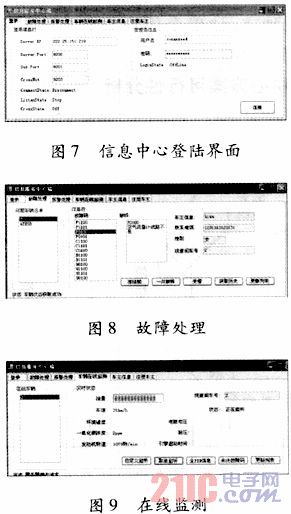
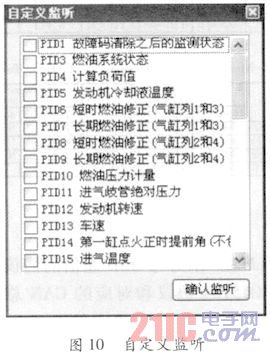
Through multiple queries and monitoring projects, you can know the status of the vehicle and deal with it.
5 Conclusion With the popularity of car use, car service is the focus of the moment. The in-vehicle system will be gradually improved and user-friendly in terms of customer service, but the service of automakers, one of the important players in the Internet of Vehicles, has not yet begun. Therefore, the proposal is mainly for automobile manufacturers, forming a prototype for the service of automobile manufacturers, and providing a reference for the construction of the newly-started automobile network in China. On this basis, major manufacturers can form certain cooperative relations with various operators, improve the service work of automobile manufacturers, and jointly promote the construction of vehicle networking.